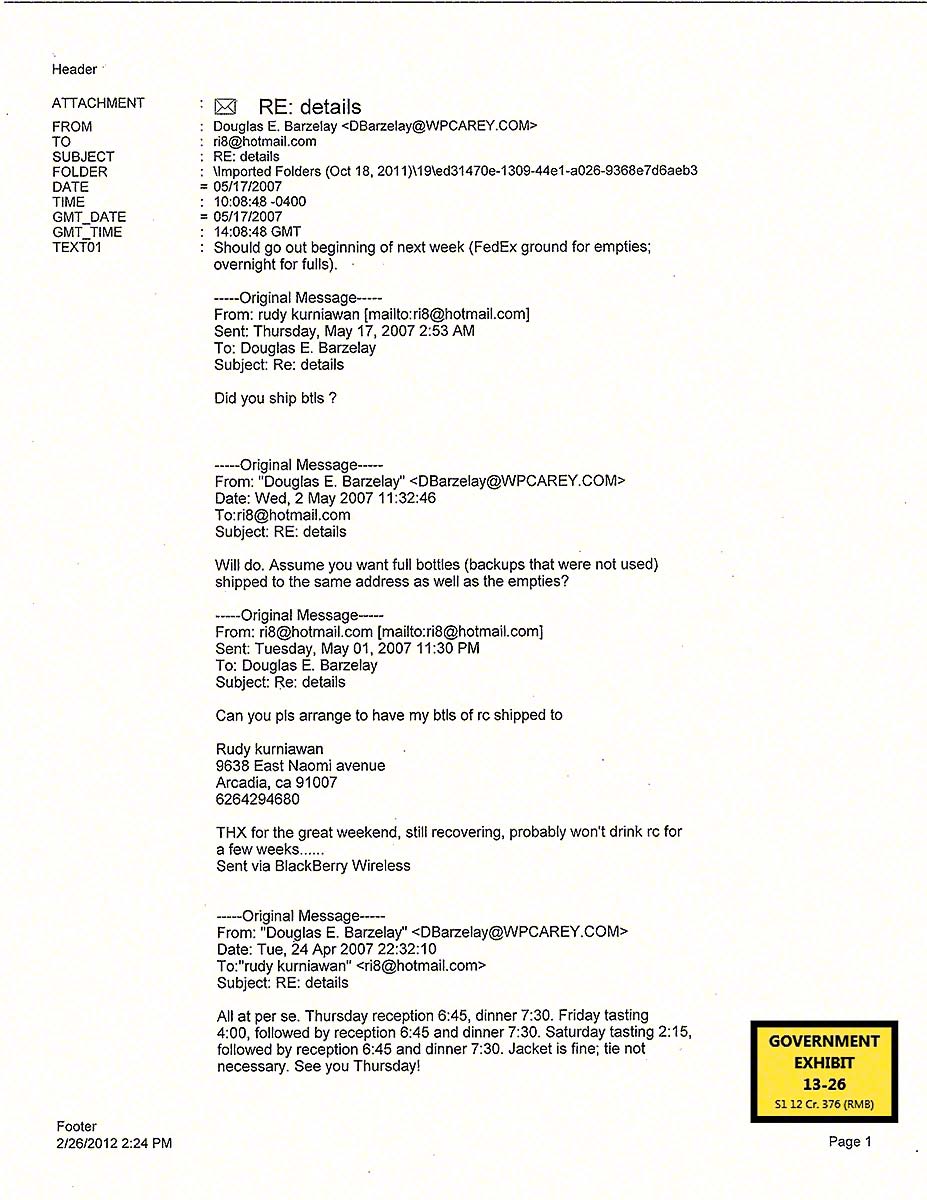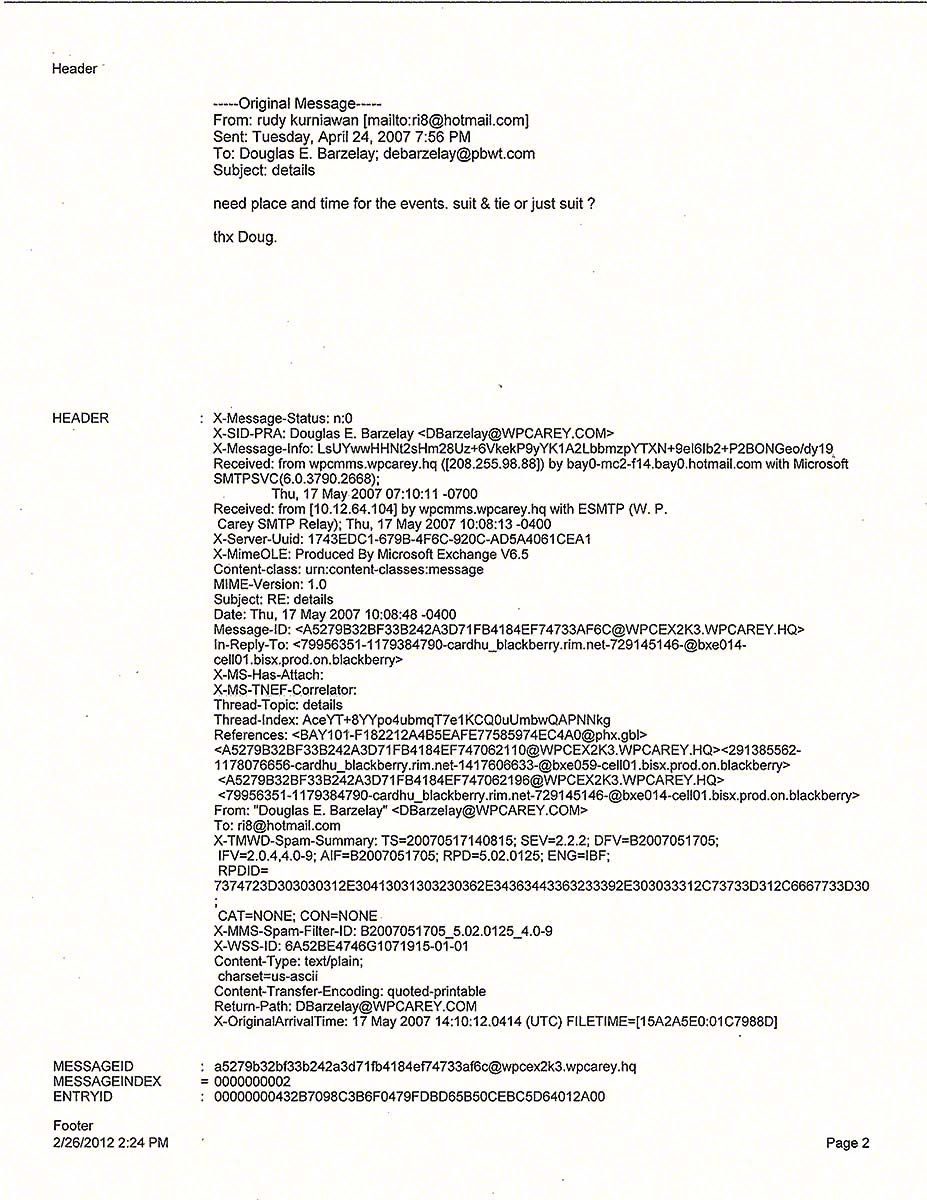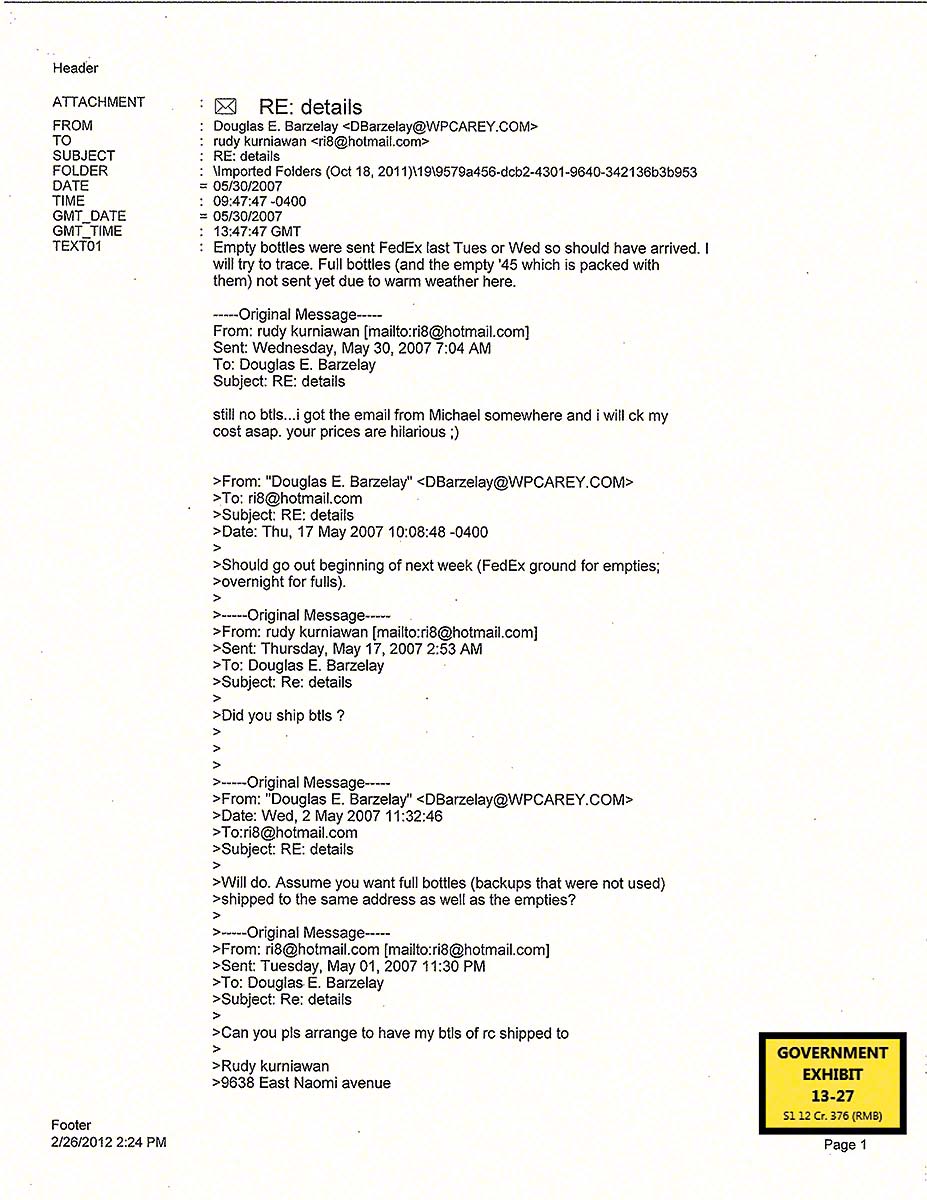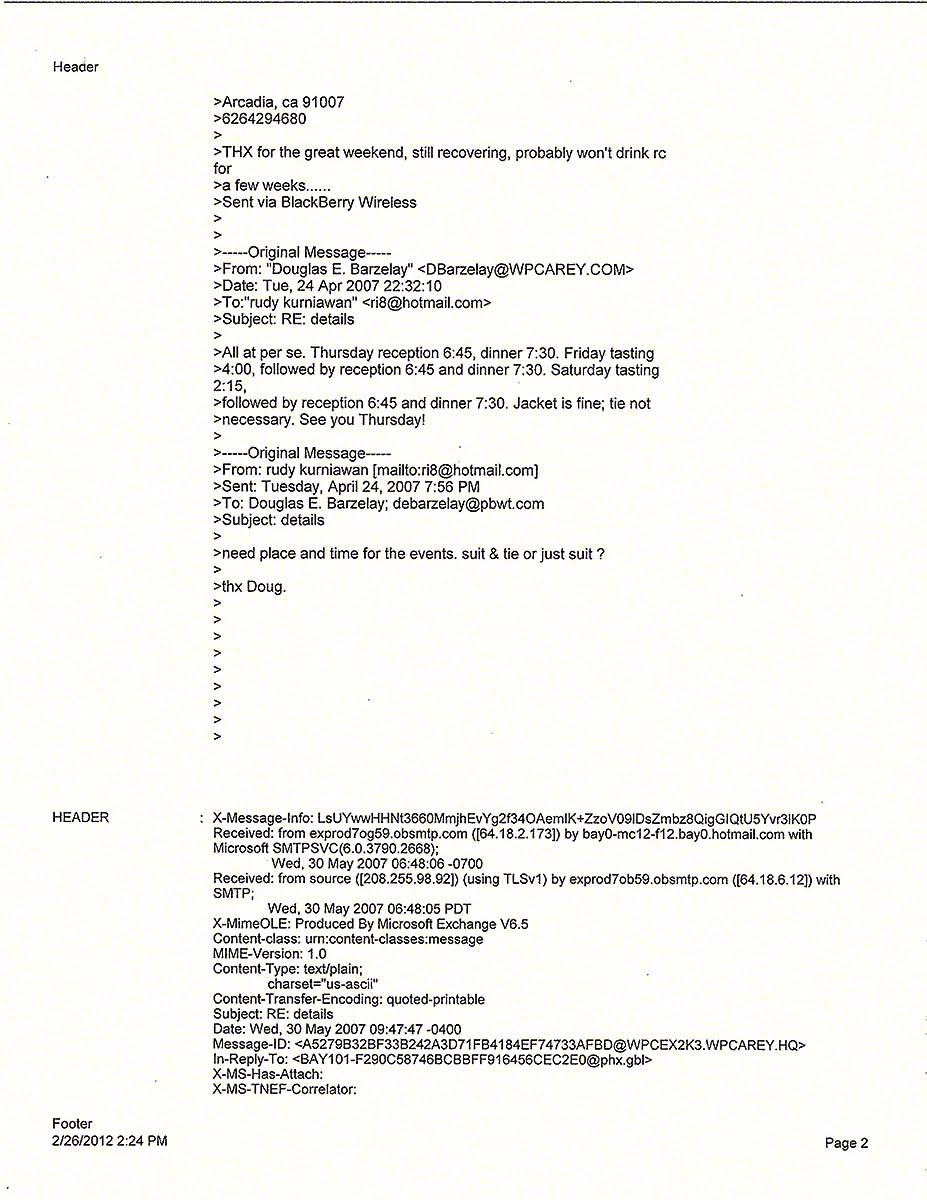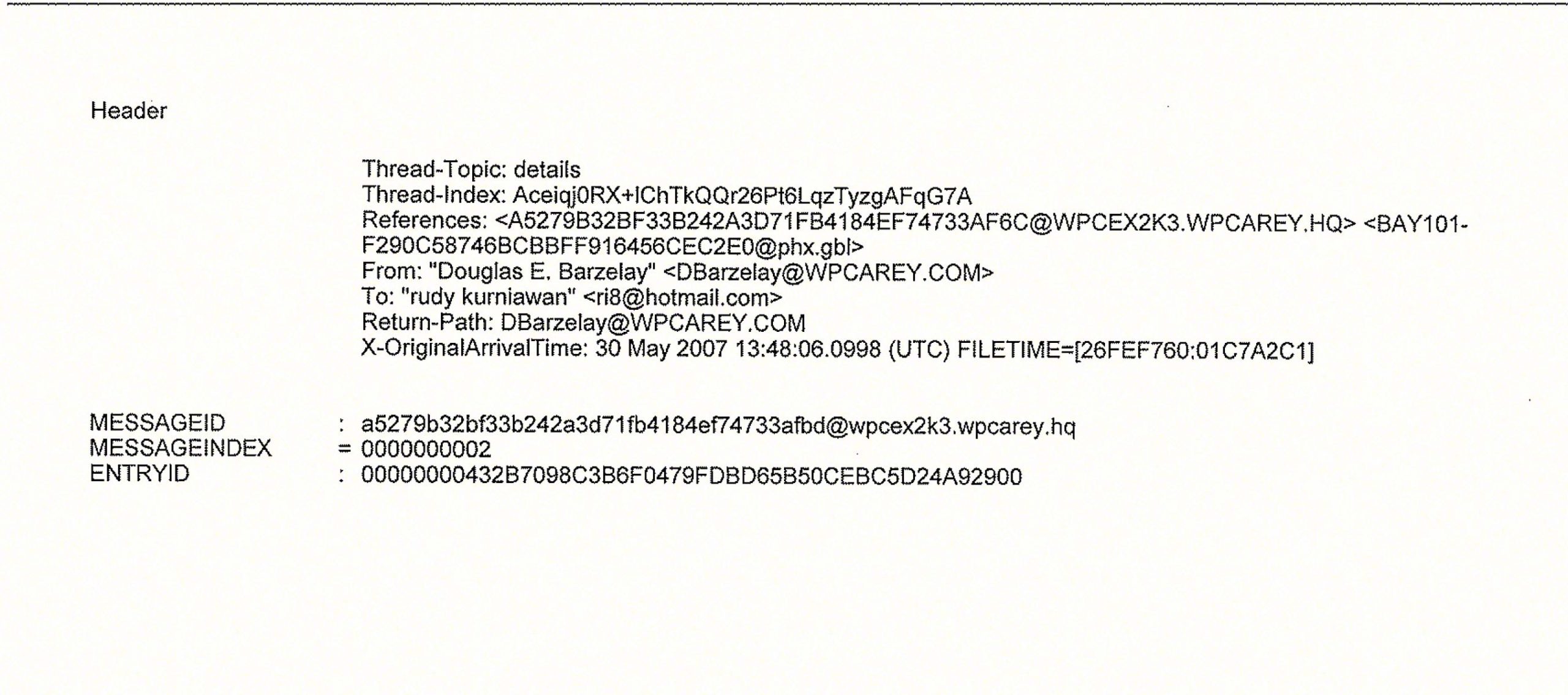The Trial: Part 10
Rudy Kurniawan’s Trial
A Multi-Part Feature on the trial of Rudy Kurniawan, including the transcripts, testimony and evidence that put the largest wine counterfeiter of our time behind bars.
Day 5: Friday 13th December (continued)
Witness, Douglas Barzelay
Jason Hernandez questioned Douglas Barzelay, a retired lawyer from Southampton, New York, who has a small business sourcing wine from private collections for restaurants, and at the time of the trial was in the process of writing a book about Burgundy.
Barzelay started collecting wine when he moved to New York in 1973, after law school. The wine market had just crashed, and it was easy to find great bottles of wine for $5 to $7 – $10 was a lot to spend on a bottle of wine. He would buy bottles with friends, put them in brown bags, taste them, argue about them, try to figure out why they liked them and defend their positions. And then, drink them. He learned a lot, and at that time there were not the journalists telling them what to think, so he and his friends had to figure out what they liked and why they liked it. Now, those same bottles are going for 50 or 100 times the price, so it was a very different world.
He began tasting mainly Bordeaux in the mid-70s, and then got interested in Burgundy. In the early 80s, the price of young Burgundy started to go up and he discovered that old Burgundy was around, and less expensive. He discovered that these older bottles had an extraordinary seamless, ethereal quality that the young ones didn’t have – people were writing Burgundy off after it was 20 years old, but he was drinking wines that were up to 50 years old, and they were amazing experiences – helped by being much cheaper than the current vintages! He therefore started buying as much as he could afford. He buys wines from auctions, retailers, brokers, and direct from the vineyards – wherever he could find things.
Barzelay confirmed he knew Rudy Kurniawan, and identified him in the courtroom. He met Kurniawan for the first time in 2004, although his reputation had preceded him. The first definite time he remembers talking to him was at Top 100 Wines set of tastings with Acker Merrall & Condit (AMC) in October 2004, and he was part of a group that went out for dinner afterwards. Over the next four years he would see Kurniawan at auctions in New York, at least once at a dinner at Cru in October 2005 that Kurniawan had invited people to and was paying for, and on several other occasions, including a major tasting of DRC wines that Barzelay and some friends put together and to which Kurniawan was invited.
Barzelay confirmed that he had had several conversations with Kurniawan about fine and rare wines, and about counterfeit wine. The first he can remember was at the Top 100 AMC tasting in 2004, as there were several wines served at that event that were clearly fraudulent. He remembered “Kurniawan saying that he had supplied a number of wines for the event, that all of his wines were correct, that he would never provide a fraudulent wine and that he was quite proficient at noting the difference”. At the dinner in October 2005, the subject came up again, and Kurniawan suggested that what they should do after such events was to deface the labels of the bottles, so they could not be reused.
Barzelay also remembered conversations with Kurniawan about physical aspects of old Burgundy wines. For example, there was a bottle of 1875 Romanée-Conti for sale in Europe, and Barzelay asked Kurniawan if he knew about it, and Kurniawan said not to buy it, because it was a fake. On a few occasions Kurniawan asked Barzelay particular questions on labels, such as whether some Roumier labels could be real.
Kurniawan would sometimes reference specific auctions he bought wine from, although once Barzelay described his response as “he just sort of gave me a half smile and referred to a magic cellar”. Doug Barzelay described Kurniawan as having a prodigious memory in general and particularly for wines, and where he had bought things from.
Barzelay confirmed that Kurniawan was, in his opinion, very knowledgeable about older Burgundy wines. He also thought Kurniawan was skilled at identifying counterfeit bottles of wine.
Barzelay confirmed that he received AMC auction catalogues, through the US mail, including the catalogues for THE Cellar and THE Cellar II in 2006. He examined the Burgundy wines offered in those two catalogues in detail, because he was very interested – those were the kinds of wines he likes to buy and drink. In the first auction, he was struck by how many old and rare bottles he had seldom seen were up for auction – it seemed remarkable. By the time of the second auction it seemed incredible. (I suspect Mr Barzelay is using the word in its proper sense here, as in, unbelievable. Not possibly true.) He gave the example of a 1959 Roumier Musigny that he had never before seen at auction, and here there was not just one bottle, but six. Only about 200 bottles were ever made and sold under the Domaine label, and there were six in the first and 12 in the second auction – or vice versa – and that sort of thing was repeated again and again in the catalogue. Wines that were very rare, and seldom if ever seen before, were now available in half case or case quantities.
Barzelay said that to the extent he could afford it, these were wines he would seek out, and agreed that there were other collectors for whom price was not an issue, and these people, including Don Stott, were very interested. Stott is an avid Burgundy collector, and an old and good friend of Barzelay, with an attitude described as “if he wanted it, he just wanted to buy it, and he was not terribly concerned about the price”.
13-26
Barzelay confirmed that he was a guest at the dinner at which Christophe Roumier was the guest of honour, at Stott’s home. He also helped to plan it. The idea started with THE Cellar I auction, when a number of people were concerned that the wines could not possibly be real, and there was the offer of a money back guarantee for anyone unhappy with the wines who returned them. Stott and he thought it would be a good idea to taste some of the wines he had bought at the auction to see if they were real, and to take advantage of the return guarantee if necessary. They invited Christophe Roumier as he would be the best source of opinion, and also Allen Meadows, a prominent critic and writer. In the course of planning that dinner, THE Cellar II sale occurred, and Stott bought additional wines from that that were included in the dinner, which took place January 2007. Barzelay knew by that point that it was Kurniawan who had consigned the wines to the auctions.
Barzelay tasted all of the wines – some of which were not from the two AMC auctions. Of those two auctions, there were 11 or 12 bottles, and of these, six or seven were clearly fraudulent. They did not taste at all as they were represented to be. Some tasted more like Rhône wines; others did not taste like wines from that year, although they were probably Burgundies of some sort. Hernandez drew Barzelay’s attention to the first page of the programme for that dinner, which was a picture of a 1923 Roumier. Barzelay confirmed he had never seen a 1923 Roumier.
13-26
Asked if his opinion of Kurniawan changed after this tasting, Barzelay said it had done so considerably. Up until that point he had thought that wines Kurniawan supplied for tastings that were fraudulent were just the normal problems of a large collector, who is almost inevitably going to have some fakes in his collection. However at this tasting, “there were so many of them, that they were so self-evidently fraudulent that I came to believe it was impossible that Rudy could not have known that these bottles were fraudulent and that he was an active and witting participant in a scheme to distribute these wines.” This was based on the fact that Barzelay knew that Kurniawan was extremely knowledgeable, and had a very fine palate, and he often talked about that and identified fraudulent wines. He was also very proud of his collection and the quality of it, and even though he was collecting a very large amount of wine, he was familiar with every single wine when they spoke, and tasted most of them a number of times. Based on all those factors, Barzelay said, “it just seemed to me no longer possible that this was just an unwitting transmission of these wines”.
Hernandez asked about the DRC tasting, which Barzelay had also helped to organise. They were trying to have the most comprehensive collection of Romanée-Conti wines that had ever been tasted in a single place at a single time. They collected 74 vintages of the wine for the tasting, that Aubert de Villaine of DRC also attended. Barzelay confirmed that Kurniawan attended, and Hernandez asked why he had been invited, given Barzelay’s negative opinion of him, formed in January 2007, to a tasting three months later. Barzelay said that the invitation had been extended about two years previously, as that was the lead time for the event. At the time of the invitation, Kurniawan was well-known as one of the premier collectors of DRC in the world. As all the people invited to the tasting were contributing wine from their cellars, Kurniawan had also sent ahead a number of wines for the tasting, which would have been done in 2006 to allow the bottles sufficient time to settle. Therefore, since he had been invited two years previously, and was contributing wine, and in particular, difficult to source wine (such as the 1945), they needed him there. Barzelay did not think there were any problems with any of those wines, and if he had missed it, he would have expected Aubert de Villaine to spot it. He confirmed that de Villaine’s attendance at the dinner had been known well ahead of time – before the wines were sent.
At the end of the dinner, the organisers asked the participants if anyone would like a bottle as a souvenir, and a few people took one with them. Kurniawan told Barzelay that he would like all of the empty bottles sent back to him in California, and the Government published an exhibit of the email exchange between Kurniawan and Barzelay confirming arrangements for this. No other participants asked to have all their empty bottles shipped to them. About two-thirds chose to take a single bottle.
In the end, the empties went out a little later than stated in the email, and the full bottles later still because of warm weather.
13-27
Kurniawan chased the bottles by email on 30th May, as shown in Exhibit 13-27.
In this email exchange, Kurniawan referred to “checking his costs”. In order to equalize people’s contributions, everyone was asked to provide their cost prices for the wines that they supplied – how much they paid for it, rather than what it was worth on the market at the time of the tasting. Barzelay asked Kurniawan several times for that information, and each time, he said he didn’t really keep records, but he’d try and find it. After waiting for ages – and everyone else waiting for Kurniawan to supply the costs in order to finalise things – one of the other organisers sent out an email saying, effectively, this is what we think they are and if you think differently, tell us.
Hernandez then moved on to 2008, and Domaine Ponsot, with which Barzelay confirmed he was familiar. He is also friendly with Laurent Ponsot, the owner. In April 2008, Barzelay received, again through the mail, a catalogue for the AMC auction of 25 April 2008. In the catalogue, there were a number of things that stood out. In particular, there was a collection of very old Clos Saint-Denis from the 40s, 50s and 60s that he was not aware existed. Therefore, he decided to check it.
13-27
The first thing he did was go to the Domaine website, which confirmed that the Domaine only started producing that wine in the early 80s, under a sharecropping agreement with the property owners. He then called a couple of friends, including Allen Meadows, to see if they were familiar with anything earlier, and they had never seen anything before about 1985. He then wondered if they had had a sharecropping agreement with anyone else, and the best way to find out was to contact Laurent Ponsot, which he did. Barzelay’s first question was when did the Domaine start making Clos Saint-Denis. At this point, Ponsot wanted a lot more information, in particular why the question was being asked, and then details of what the auction was.
Before the auction, Barzelay had contacted John Kapon of AMC to tell him that the bottles were clearly fraudulent, and they needed to be withdrawn, and they had several conversations about it. At the auction itself, Kapon announced that the bottles were being withdrawn at the request of the Domaine.
13-27
The following day, Doug Barzelay had lunch with John Kapon, Rudy Kurniawan and Laurent Ponsot, at the request of Kapon, who wanted Kurniawan to tell Ponsot where he got the bottles. The question of where the bottles came from came up several times over lunch. Barzelay found Kurniawan’s demeanour at that lunch, and especially when asked about the source of the bottles, nervous, fidgety, much quieter and less self-assured than normal. In general, he seemed very uncomfortable. When pressed on where the bottles came from, he said he could not remember, and he would need to go back and check his records. Barzelay found this to be completely incredible, as in, totally lacking in credibility. His prior experience of Kurniawan was that he seemed to know in great detail the history of pretty much every bottle; the idea that he did not know where these ones came from did not seem credible. Given the conversations they had had about his general lack of record keeping, Barzelay also doubted that there were any records that he would be going back to check. In general, he seemed to be trying to evade the question, and every time it came up, as soon as he gave that answer, he would then try and change the subject.
Douglas Barzelay, cross-examination
Jerome Mooney rose to cross-examine Barzelay. He asked him about his writing – the book he was working on, and the blog he writes, and in which he has been clear on his views of how Kurniawan has defrauded wine collectors.
Barzelay confirmed that he had first heard of Kurniawan through the grapevine, with the news that this guy was spending millions of dollars buying wine. Rudy then started turning up to dinners. At the two or three dinners that Mr Barzelay attended, in New York, Kurniawan would normally buy wines off the list, and although he understood that Kurniawan ‘spractice in Los Angeles was different, he had no direct experience of it. There were normally eight to 10 people present, including on one or two occasions Allen Meadows, whom Barzelay described as a respected wine journalist.
Mooney then asked if Don Stott was someone you would want to get close to if you wanted to be a player in the wine collecting community, and Barzelay agreed, and with the statement that Rudy Kurniawan and Don Stott would often be on the same side of the bidding. This happened, for example, at the Doris Duke auction, which had multiple cases of 1934 Romanée-Conti, of which Kurniawan bought some.
Barzelay confirmed that at the Cru dinner mentioned above, Kurniawan paid for everything – the wine and the dinner. Mooney suggested that important, influential people would whom one would be willing to buy dinner for. Barzelay contradicted him, and said that that is not what this business is about. Customers would actually be primarily restaurant sommeliers.
Barzelay then confirmed that Kurniawan was a very young man when they first met. He said of himself that he was fairly knowledgeable about Burgundy, but was not an expert, and knew little about areas outside Burgundy. He did wonder how Kurniawan had gained his knowledge, and how deep it was. He did agree that Kurniawan seemed to have an excellent palate, although he had not personally experienced Kurniawan blind tasting prowess. Barzelay did note that when Kurniawan asked him about a Roumier label, by email, he did not respond, because it was after the time when he had come to question why Kurniawan was asking these things.
Break
The jury took a break, and Judge Berman, Jason Hernandez and Jerome Mooney discussed the rest of the witnesses, and when they expected to finish. Hernandez noted that it sounded as if Kurniawan was not going to testify, and it would be useful to know that, but the judge said that he always gives the defence a bit of latitude in that regard. Mooney added that he always gives his client the final decision, but he thinks it is highly unlikely. Judge Berman urged him to discuss it with his client at length. Mooney noted that all he can do is make recommendations – some people follow them and some people don’t. Judge Berman spoke directly to Kurniawan, to inform him of the timings, and that his counsel had indicated that whether or not he testified would be entirely up to him.
Doug Barzelay, cross-examination, cont’d
Jerome Mooney resumed by asking about the Don Stott dinner, many of the wines for which had been purchased at THE Cellar I and II auctions in 2006. Doug Barzelay confirmed that of the 15 bottles that were served that night, 11 or 12 of them came via Kurniawan, and that six or seven of these were fakes. Mooney asked if Barzelay recalled telling Stanley Los, Bill Koch’s investigator, that there were four fakes: a 55 Musigny and Bonnes-Mares from ’23, ’29 and ’45. Barzelay replied that he recalled those wines were fake, but that there were two bottles of each of the ’55 and 23. He confirmed these were part of the list of 11.
Barzelay confirmed that he subsequently went through Stott’s cellar, and found a number of anomalies, stressing these were of wines purchased in THE Cellars I and II. It was not a general review of the cellar, but a specific search of those wines, because Stott wanted to return bottles under the terms of the guarantee. They found bottles that seemed to have fraudulent labels but authentic wine, and bottles that did not appear real, with similar fake labels. Barzelay had written about this on his blog in 2012.
With respect to the DRC tasting, Kurniawan supplied about a dozen bottles that were used, although Barzelay was not certain. There were also bottles Kurniawan supplied that were not used in the tasting. Mooney pointed out that in the email Kurniawan does not specify that he is asking for the empties –Barzelay has made that assumption. He argues that it is reasonable of Kurniawan to want his (full, unopened) bottles back, and that it’s not at all suspicious that someone with in the region of a case of very expensive wine might want it back in his possession. Barzelay confirmed that the tasting went off well, and that the highlight of the evening was the bottle of 1945 that Rudy supplied. This bottle was signed by all the people at the tasting, including Aubert de Villaine, and was included in the shipment back to Kurniawan. Barzelay agreed that if that were his bottle, he would want it back.
Turning to the Ponsot wines, and the lunch afterward, Mooney suggested that it was natural that Kurniawan looked embarrassed and fidgety, having consigned what were clearly fakes into the auction. Mooney then said that that to this day, Barzelay doesn’t really know where the Ponsot wines came from; Barzelay agreed he did not.
Douglas Barzelay, redirect
Hernandez returned Barzelay’s attention to his blog, and specifically the comment made about authentic wine and fake labels. He asked why Barzelay had written this, and was told that in that article, Barzelay was trying to be as comprehensive as he could be with his understanding of what had happened.
Barzelay said that although Kurniawan had said he did not keep records, his impression was that it was more that Kurniawan did not have any organised set of records. However, Barzelay had no personal knowledge of Kurniawan record keeping or lack of it.
Finally, he confirmed that Kurniawan asked for all the empty bottles back, not just the signed ’45. The only bottle that had been signed was the 1945.
Oral application from the Government
At this point, Hernandez made an oral application. He said that he felt it was too late for the defence to provide notice that they were going to call a handwriting expert. The only handwriting in question is 36-1, the note that Rudy scribbled with the two phone numbers on it, and the defence has had this through discovery from the beginning. Furthermore, it has been mentioned in virtually every interview with Laurent Ponsot in every article about the trial. It is no secret that the government was going to bring the fact out, and now to be told that they are going to call an expert on Tuesday, the government will not be able to call an expert to rebut that, to analyse the report. The Government therefore made an application to preclude the defence from making this eleventh hour motion for an expert.
Mooney argued that they had not had the materials until just before trial, which Judge Berman pointed out was a week ago. Mooney then argued that there were three different versions Ponsot had told about the note at different times, including one where he said that he wrote it down, one where he said Kurniawan supplied it, and the one he testified to, that Kurniawan wrote it down in front of him. Mooney argued that it didn’t look anything like Kurniawan’s handwriting, at which point the judge asked him if he thought Laurent Ponsot made up the numbers. Judge Berman then said that they needed to submit letter briefs; the government that day by 7pm, the defence the next day, by 2pm, after they had looked at the government’s submission. He urged them to come up with a stipulation if possible.
Click here for part 11.
